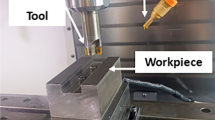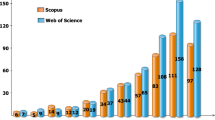Abstract
The application of cutting fluid is required to enable efficient machining processes. Depending on the process, additives are used to adjust the performance of the cutting fluid. This paper presents the strong influence of nanoparticles and microparticles on the cutting fluid properties as well as the tribological behavior. The effects of the particle size, the concentration and the base fluid were investigated for two different metal oxides, Al2O3 and ZrO2, as well as silica. While most nanoparticles achieved an improved lubricity, the opposite was found for Al2O3.













Similar content being viewed by others
References
Denkena, B., & Tönshoff, H. K. (2011). Spanen. Berlin: Springer.
DIN 51385. (2013). Schmierstoffe—Bearbeitungsmedien für die Umformung und Zerspanung von Werkstoffen—Begriffe. Berlin: Beuth Verlag GmbH.
Brinksmeier, E., Meyer, D., Huesmann-Cordes, A. G., & Herrmann, C. (2015). Metalworking fluids—mechanisms and performance. CIRP Ann Manuf Technol, 64(2), 605–628.
Winter M., Öhlschläger G., Dettmer T., Ibbotson S., Kara S. & Herrmann C., Using Jatropha oil based metalworking fluids in machining processes: A functional and ecological life cycle evaluation. Proceedings of the 19th CIRP Conference on Life Cycle Engineering, pp. 311–316, 2012.
Winter, M., Bock, R., Herrmann, C., Stache, H., Wichmann, H., & Bahadir, M. (2012). Technological evaluation of a novel glycerol based biocide-free metalworking fluid. Journal of Cleaner Production, 35, 176–182.
Winter, M., Bock, R., & Herrmann, C. (2013). Investigation of a new polymer-water based cutting fluid to substitute mineral oil based fluids in grinding processes. CIRP Journal of Manufacturing Science and Technology, 6(4), 254–262.
Zhao F, Skerlos SJ, Clarens AF, Hayes KF (2017) Evaluating activation conditions for extreme pressure additives in metalworking fluids using the thread forming test. 35th North American Manufacturing Research Conference. Vol. 35, pp. 351–358, 2017.
Landau H. (1986). Chlorparaffine als EP-Additive in Metall-bearbeitungsflüssigkeiten. 5. Internationalen Schmierstoff-Kolloquium in Esslingen
Schulz, J., & Holweger, W. (2010). Wechselwirkung von Additiven mit Metalloberflächen. Renningen: Expert-Verlag.
Madanchi N., Kurle D., Winter M., Thiede S. and Herrmann C. (2015) Energy efficient process chain: The impact of cutting fluid strategies. In Proceedings of the 22th CIRP Conference on Life Cycle Engineering (Vol. 29, pp. 360–365).
Jawahir, I. S., Attia, H., Biermann, D., et al. (2016). Cryogenic manufacturing processes. CIRP Annals Manufacturing Technology, 65(2), 713–736.
Weinert, K. (1999). Trockenbearbeitung und Minimalmengen-kühlschmierung: Einsatz in der spanenden Fertigungstechnik. Berlin: Springer.
Weinert, K., Inasaki, I., Sutherland, J. W., & Wakabayashi, T. (2004). Dry machining and minimum quantity lubrication. CIRP Annals Manufacturing Technology., 53(2), 511–537.
Deutsche Gesetzliche Unfallversicherung (DGUV). (2010). Minimum quantity lubrication for machining operations. Berlin, BGI/GUV-I 718 E
Neugebauer R., Wertheim R. & Harzbecker C. (2011). Energy and resources efficiency in the metal cutting industry. In: Seliger G, Khraisheh MM, Jawahir IS, eds. Advances in sustainable manufacturing: Proceedings of the 8th Global Conference on Sustainable Manufacturing. Berlin, Heidelberg, Springer-Verlag Berlin Heidelberg, pp. 249–259.
Taylor, R., Coulombe, S., Otanicar, T., et al. (2013). Small particles, big impacts: A review of the diverse applications of nanofluids. Journal of Applied Physics, 113(1), 11301.
Agarwal, D. K., Vaidyanathan, A., & Kumar, S. S. (2015). Investigation on convective heat transfer behaviour of kerosene-Al2O3 nanofluid. Applied Thermal Engineering, 84, 64–73.
Ghadimi, A., Saidur, R., & Metselaar, H. (2011). A review of nanofluid stability properties and characterization in stationary conditions. International Journal of Heat and Mass Transfer, 54(17–18), 4051–4068.
Sridhara, V., & Satapathy, L. N. (2011). Al2O3-based nanofluids: A review. Nanoscale Research Letters, 6, 456.
Kleinstreuer, C., & Feng, Y. (2011). Experimental and theoretical studies of nanofluid thermal conductivity enhancement: A review. Nanoscale Research Letters, 6(1), 229.
Saidur, R., Leong, K. Y., & Mohammad, H. A. (2011). A review on applications and challenges of nanofluids. Renewable and Sustainable Energy Reviews, 15(3), 1646–1668.
Sidik, N., Yazid, M., & Mamat, R. (2015). A review on the application of nanofluids in vehicle engine cooling system. International Communications in Heat and Mass Transfer, 68, 85–90.
Ansarifar, G. R., & Ebrahimian, M. (2016). Design and neutronic investigation of the Nano fluids application to VVER-1000 nuclear reactor with dual cooled annular fuel. Annals of Nuclear Energy, 87, 39–47.
Murshed, S. S., & Estellé, P. A. (2017). state of the art review on viscosity of nanofluids. Renewable and Sustainable Energy Reviews, 76, 1134–1152.
Stolzenburg, P., & Garnweitner, G. (2017). Experimental and numerical insights into the formation of zirconia nanoparticles: A population balance model for the nonaqueous synthesis. Reaction Chemistry and Engineering, 2, 337–348.
Breitung-Faes, S., & Kwade, A. (2014). Use of an enhanced stress model for the optimization of wet stirred media milling processes. Chemical Engineering and Technology, 37(5), 819–826.
Lee, P.-H., Nam, J. S., Li, C., & Lee, S. W. (2012). An experimental study on micro-grinding process with nanofluid minimum quantity lubrication (MQL). International Journal of Precision Engineering and Manufacturing, 13(3), 331–338.
Shen, B., Shih, A. J., & Tung, S. C. (2008). Application of nanofluids in minimum quantity lubrication grinding. Tribology Transactions, 51(6), 730–737.
Lee, P.-H., Lee, S. W., Lim, S.-H., Lee, S.-H., Ko, H. S., & Shin, S.-W. (2015). A study on thermal characteristics of micro-scale grinding process using nanofluid minimum quantity lubrication (MQL). International Journal of Precision Engineering and Manufacturing, 16(9), 1899–1909.
Mao, C., Tang, X., Zou, H., Huang, X., & Zhou, Z. (2012). Investigation of grinding characteristic using nanofluid minimum quantity lubrication. International Journal of Precision Engineering and Manufacturing, 13(10), 1745–1752.
Mao, C., Huang, Y., Zhou, X., Gan, H., Zhang, J., & Zhou, Z. (2014). The tribological properties of nanofluid used in minimum quantity lubrication grinding. The International Journal of Advanced Manufacturing Technology., 71(5–8), 1221–1228.
Wang, Y., Li, C., Zhang, Y., Yang, M., Zhang, X., Zhang, N., et al. (2017). Experimental evaluation on tribological performance of the wheel/workpiece interface in minimum quantity lubrication grinding with different concentrations of Al2O3 nanofluids. Journal of Cleaner Production., 142, 3571–3583.
Wang, Y., Li, C., Zhang, Y., Yang, M., Li, B., Dong, L., et al. (2018). Processing characteristics of vegetable oil-based nanofluid MQL for grinding different workpiece materials. International Journal of Precision Engineering and Manufacturing-Green Technology, 5(2), 327–339.
Sinha, M. K., Madarkar, R., Ghosh, S., & Rao, P. V. (2017). Application of eco-friendly nanofluids during grinding of Inconel 718 through small quantity lubrication. Journal of Cleaner Production., 141, 1359–1375.
Knieke, C., Sommer, M., & Peukert, W. (2009). Identifying the apparent and true grinding limit. Powder Technology, 195(1), 25–30.
Stenger, F., MEnde, S., Schwedes, J., & Peukert, W. (2005). The influence of suspension properties on the grinding behavior of alumina particles in the submicron size range in stirred media mills. Powder Technology, 156, 103–110.
Zellmer, S., Titscher, P., Wienken, E., Kwade, A., & Garnweitner, G. (2017). Fabrication of carbon-sulphur composites via a vibration mill process as cathode material for lithium sulphur batteries. Energy Storage Materials, 9, 70–77.
Tkáčová, K., Heegn, H., & Števulová, N. (1993). Energy transfer and conversion during comminution and mechanical activation. International Journal of Mineral Processing, 40, 17–31.
Heegn, H. (1990). Mechanische Aktivierung von Festkörpern. Chemie Ingenieur Technik, 62, 458–464.
Acknowledgements
The authors gratefully acknowledge Benedikt Finke, Institute of Particle Technology, TU Braunschweig, for the support in post-processing the rheological data. The SEM pictures were kindly taken by Peter Pfeiffer, Institute of Material Science.
Author information
Authors and Affiliations
Corresponding author
Additional information
Publisher's Note
Springer Nature remains neutral with regard to jurisdictional claims in published maps and institutional affiliations.
Electronic Supplementary Material
Below is the link to the electronic supplementary material.
Rights and permissions
About this article
Cite this article
Madanchi, N., Zellmer, S., Winter, M. et al. Investigation on the Effects of Nanoparticles on Cutting Fluid Properties and Tribological Characteristics. Int. J. of Precis. Eng. and Manuf.-Green Tech. 6, 433–447 (2019). https://doi.org/10.1007/s40684-019-00053-0
Received:
Revised:
Accepted:
Published:
Issue Date:
DOI: https://doi.org/10.1007/s40684-019-00053-0




